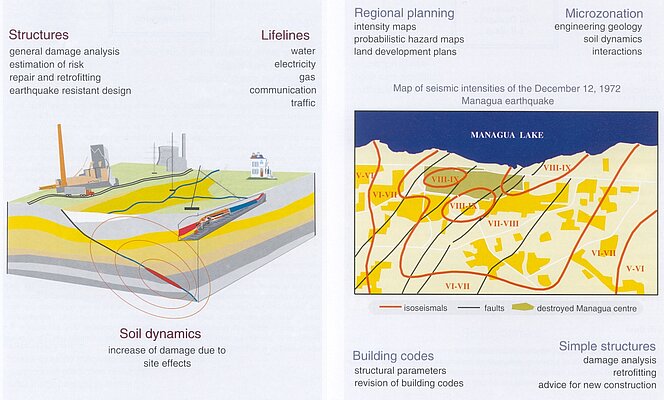Engineering Group of German TaskForce for Earthquakes
Structures
The task force engineering team documents earthquake-related damage to buildings and other man-made structures and systems. Once in the epicentral region, team members carry out a complex analysis of the damage taking into account macro seismic and instrumental data along with the current building codes and the underlying engineering data. The analysis includes non-damaged structures which may be regarded as examples of earthquake resistant design.
The analysis helps to estimate the danger to rescue troops, develop methods for repairing and strengthening damaged structures and provide advice for reconstruction and earthquake resistant design.
Soil Dynamics
Damage can be exacerbated by soil- and ground behaviour during earthquake-induced shaking. Documentation of geodynamic and hydrodynamic effects along with secondary features such as subsidence, landslides and dam failures together with the analysis of soil-related damage
supports the reconstruction planning and sets the framework for future projects in the epicentral area.
Lifelines
Damage to water, electricity, gas supplies and communications systems along with disruption of traffic routes often leads to secondary damage which exacerbates the catastrophe. Through the recording and analysis of damage to lifeline systems dangerous situations can be recognized and mitigating measures can be implemented immediately.
Regional Planning
After the earthquake, planning in the epicentral region must recognize and deal with the possibility of future earthquakes. Planning authorities should make use of intensity maps to estimate the effects of possible future shocks on structures and infrastructure in the area. With the help of probabilistic risk maps, zoning plans can be developed which improve earthquake safety.
Microzonation
Microzonation, particularly in urban areas, documents near surface soil structure and dynamic building site influences which affect the interaction between the substrate and the structure. The extent of damage, and geologic maps developed by engineering geologists (rarely available) allow a dynamic characterization of building sites. This information influences local building
codes and is essential for new construction and the reconstruction of critical buildings.
Building Codes
Documentation and analysis of structural damage leads to a re-evaluation of the load parameters. As the seismic potential in a region can change, the codes have to be re-evaluated and revised after each major event. Often the underlying rules for generating a building code for a particular area must be extended, modified or redefined.
Simple Structures
In developing countries personal injuries often occur in poorly engineered structures. Documentation of the behaviour of such structures during earthquakes is an important task. Lessons for improved safety learned from such observations are a prerequisite for the reduction of future personal injuries and damage. In a second step, help can be given for the reconstruction of typical structures.


